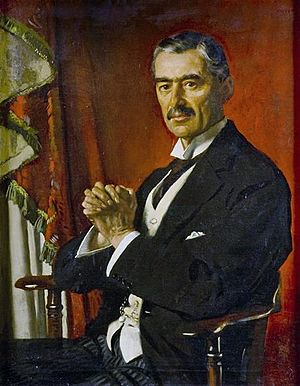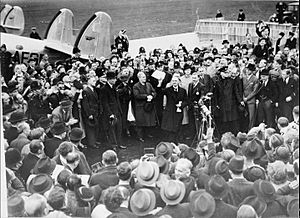Neville Chamberlain facts for kids
Quick facts for kids
The Right Honourable
Neville Chamberlain |
|
|---|---|
 |
|
| Prime Minister of the United Kingdom | |
| In office 28 May 1937 – 10 May 1940 |
|
| Preceded by | Stanley Baldwin |
| Succeeded by | Winston Churchill |
| Chancellor of the Exchequer | |
| In office 5 November 1931 – 28 May 1937 |
|
| Prime Minister | Ramsay MacDonald |
| Preceded by | Philip Snowden |
| Succeeded by | John Allsebrook Simon |
| In office 27 August 1923 – 22 January 1924 |
|
| Prime Minister | Stanley Baldwin |
| Preceded by | Stanley Baldwin |
| Succeeded by | Philip Snowden |
| Personal details | |
| Born | 18 March 1869 Edgbaston, Birmingham, England |
| Died | 9 November 1940 (aged 71) Highfield Park, Reading, Berkshire, England |
| Political party | Conservative |
Arthur Neville Chamberlain (pronounced: CHAIM-BER-LIN; born 18 March 1869 – died 9 November 1940) was an important politician in Britain. He was the Prime Minister of the United Kingdom from 1937 to 1940. Before that, he was the Lord Mayor of Birmingham and the Chancellor of the Exchequer, which means he was in charge of the country's money.
Contents
Neville Chamberlain's Early Life
Neville Chamberlain was born in Edgbaston, a part of Birmingham, England. His father, Joseph Chamberlain, was a very important politician. His half-brother, Austen Chamberlain, also became a well-known politician.
Education and Hobbies
Neville went to Rugby School. He loved learning about plants (this is called botany). He also enjoyed watching birds and going fishing. Music and reading (which is called literature) were also big interests for him. He studied metallurgy, which is about how metals are made and used. He learned this at Mason College, which later became part of the University of Birmingham. After college, he worked as an apprentice at an accounting company.
Starting in Local Politics
Neville became a successful manager at a company that made things. In 1911, when he was 42, the people of Birmingham elected him to their city council. On the council, he worked on making the city better, just like his father had done. He helped plan new homes for people who needed them. In 1915, he became the Lord Mayor of Birmingham. In this role, he continued to improve the city, and he even helped start the City of Birmingham Symphony Orchestra.
Becoming a Member of Parliament
In 1916, the Prime Minister at the time, David Lloyd George, asked Chamberlain to manage a government department. This department was in charge of conscription, which meant making regular people become soldiers during wartime. Chamberlain and Lloyd George often disagreed, and they soon didn't get along. Chamberlain left that job the next year.
Instead, he decided to become a Member of Parliament (MP) in the 1918 general election. He won and became the Conservative MP for Ladywood in Birmingham.
Working in Government Roles
In 1923, Prime Minister Andrew Bonar Law made Chamberlain the health minister. In this job, Chamberlain worked to help people who were struggling. For example, he created a law that linked how much rent people paid to how good their homes were.
Chancellor of the Exchequer
Chamberlain then became the Chancellor of the Exchequer for a short time. This job meant he was in charge of the country's money and economy. After the 1924 general election, he became health minister again. He stayed in this role until the Conservatives lost the 1929 election. Between 1924 and 1929, Chamberlain helped create many new laws to support people. This included a pensions system, which helped create Britain's welfare state after World War II.
Economic Challenges and Tariffs
In 1929, the Conservatives lost the election, and Ramsay MacDonald from the Labour Party became Prime Minister. At this time, the Conservative party wanted to put tariffs (extra taxes) on goods brought into the country. They hoped this would make trade stronger within the British Empire. Some people, like Lord Beaverbrook, who owned many newspapers, disagreed. They thought trade should be free. Chamberlain ran against Lord Beaverbrook's new party in an election and won. This made him very popular in the Conservative party.
An economic crisis in 1931 led to another general election. After this election, Chamberlain became Chancellor of the Exchequer again. He worked to cancel debts that Britain had from the war. In 1932, he was able to start the tariff system he wanted. His father, Joseph Chamberlain, had also worked hard for a tariff system. Neville was happy to make his father's wishes come true.
War Becomes More Likely
By 1934, Chamberlain felt that Britain's economy was getting better. However, some important people, including Chamberlain's half-brother Austen and Winston Churchill, warned that Nazi Germany was building up its military again. They said Britain needed to do the same. In July 1934, the government announced a plan to make the Royal Air Force much stronger.
Public Opinion and Rearmament
Not everyone wanted to build up the military. Many people remembered the terrible First World War and wanted to avoid another war. This feeling was called pacifism. Chamberlain advised the Prime Minister, Stanley Baldwin, to talk about making the military stronger in the 1935 election. But Baldwin was worried people wouldn't vote for them if they did. So, he talked about housing and unemployment instead.
Chamberlain worked hard to improve the economy and prepare for possible war. The government bought unused factories and updated them. This helped Britain have modern equipment when the war started. In 1936, the government also announced plans to build up the Royal Navy.
Becoming Prime Minister
Stanley Baldwin retired in 1937, and Neville Chamberlain became the new Prime Minister on May 28th. Chamberlain is mostly remembered for leading Britain as Europe moved into World War II. But as Prime Minister, he also made important changes in Britain itself.
Changes in Britain
He created laws that made working conditions better for people. He limited the number of hours women and children could work. He also introduced paid holidays for many workers. He brought in laws to try and make the population healthier through exercising and medical checks. Many other changes were planned, but the start of the war stopped them.
Agreements with Ireland
In the 1930s, the Irish leader, Éamon de Valera, wanted Ireland to be fully independent from Britain. Ireland had its own government, but Britain still controlled Northern Ireland and had naval ports in Ireland. De Valera wanted this control to stop. Chamberlain wanted Ireland to support Britain if there was a war. He knew that defending the Atlantic Ocean would be hard without Ireland's help.
Chamberlain and his Secretary of State, Malcolm MacDonald, made an agreement to give the naval ports back to Ireland. They hoped British warships might still use them if war broke out. Many Conservatives, including Winston Churchill, strongly disagreed with this plan. This agreement, along with a plan to limit the number of Jewish people moving into Palestine (which Britain controlled), made Chamberlain unpopular with some people.
The Munich Agreement
Many people warned about the danger of Nazi Germany. However, Chamberlain chose ministers who agreed with him and wanted to avoid war. Chamberlain and many people his age were very worried about another war. They believed that leaders like Adolf Hitler were powerful because their people felt things were unfair. German people felt the Treaty of Versailles (an agreement that ended the First World War) was unfair.
When Nazi Germany took control of Austria and the Sudetenland (a part of Czechoslovakia), Chamberlain tried to keep peace. In September 1938, he flew to Munich to talk with Hitler. With the French Prime Minister, Édouard Daladier, and the Italian leader, Benito Mussolini, he made an agreement with Hitler. Hitler was allowed to control the Sudetenland. In return, he promised not to use his military to solve future disputes (disagreements).
When Chamberlain returned home, many people praised him. Chamberlain was very happy and said the agreement meant "peace for our time."
The Start of World War II
In March 1939, the German military took control of the rest of Czechoslovakia. This went against the Munich agreement. Chamberlain realized that his attempts to control Hitler had failed. He started getting Britain ready for war, using the new factories that had been built. Many new weapons were made, including the Supermarine Spitfire (a fighter aircraft) and radar.
When the Germans invaded Poland on 1st September 1939, Britain and France talked and decided to declare war on Germany. Chamberlain spoke on the radio and told the British people that war had begun.
Chamberlain's Resignation
Chamberlain formed a new government and included Winston Churchill. After the Germans invaded Norway in April 1940, the British sent a naval force to fight them. This plan did not succeed, and Parliament no longer supported Chamberlain. On 10 May 1940, Chamberlain resigned as Prime Minister. Churchill became the new Prime Minister, but Chamberlain stayed in the government.
Later in May, Germany offered conditions for peace. Most of the government, including Chamberlain, wanted to agree and stop fighting. But Churchill did not want to agree. He spoke with Chamberlain, and soon Chamberlain began to agree with Churchill. Because of this, Britain stayed in the war.
Death and Legacy
In the summer of 1940, Chamberlain became sick. In July, he had an operation on his stomach to treat cancer. He tried to return to work, but he became too weak and had to retire. He died on 9 November 1940, at 71 years old, from bowel cancer.
Winston Churchill spoke to Parliament about Chamberlain's death. He praised Chamberlain as a good and honest man. People still disagree about Chamberlain's actions. Some think he was wrong for not stopping Hitler sooner. Others say he gave Britain and France more time to get ready for war.
Images for kids
-
Joseph Chamberlain (seated) and Austen Chamberlain, 1892
-
1929 portrait of Chamberlain by William Orpen
-
Chamberlain (centre, hat and umbrella in hands) walks with German Foreign Minister Joachim von Ribbentrop (right) as the Prime Minister leaves for home after the Berchtesgaden meeting, 16 September 1938. On the left is Alexander von Dörnberg.
-
From left to right, Chamberlain, Daladier, Hitler, Mussolini and Italian Foreign Minister Count Galeazzo Ciano as they prepare to sign the Munich Agreement
-
David Lloyd George, prime minister 1916–22, whose contempt for Chamberlain was reciprocated
-
Blue plaque honouring Neville Chamberlain, Edgbaston, Birmingham
See also
 In Spanish: Neville Chamberlain para niños
In Spanish: Neville Chamberlain para niños











